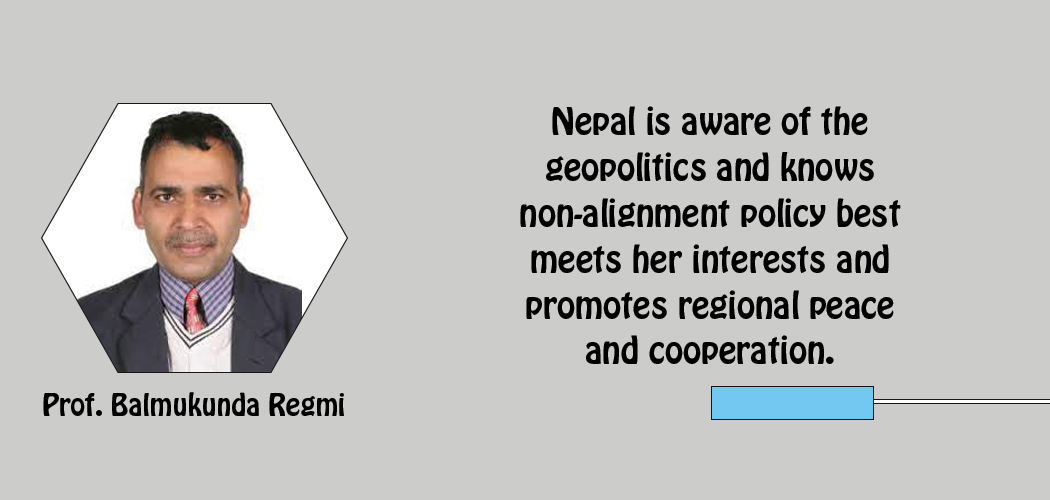- Thursday, 18 December 2025
Non-aligned Foreign Policy Reaffirmed
Prof. Balmukunda Regmi
Decolonisation movement followed the Second World War. Nepal was never colonised, but unfair terms imposed over her did not end with the disintegration of the British Empire. Aiming to diversify foreign relations, the Rana rulers established diplomatic relations with the USA in 1947. Our diplomatic drive continued. Nepal joined the UN, and established diplomatic relation with China, both in 1955. These steps further solidified Nepal’s status of an independent country. Nepal actively participated in the 1955 Bangdung conference that embraced five principles of Panchasheel, based on the teachings of Gautam Buddha.
Zone of Peace
Directly or indirectly, Nepal has been seeking an escape to the existing special relation with India. Addressing the UN General Assembly in 1960, Prime Minister BP Koirala said, Nepal judged every international issue on its merit without consideration of anybody’s fear or favour. Nepal became a formal member of the non-aligned movement (NAM) in 1961. In 1975, King Birendra proposed to make Nepal a Zone of Peace (ZoP), which garnered support of over 130 countries out of the then existing 135 countries but could not get Indian and Russian support. It was put in limbo with the introduction of multiparty system in 1990. These efforts can be viewed as the extension of the instructions of Prithvi Narayan Shah.
The collapse of the Soviet Union in 1991 gave way to the US-led unipolar world order, ending the cold war and fizzling out the core concept of the NAM. Slowly Europe, East Asia and Africa tried to develop regionalism while the countries like China, India, South Africa and Russia began to make the world multipolar. Yet, the US-led NATO absorbed the former Soviet-led Warsaw Pact members and former Soviet republics, pushing its territory toward the Russian border.
Meanwhile, the equilibrium of global power balance is changed, and it has drifted away from the US. Disgraced, Russia had deep resent against the US. Vladimir Putin successfully capitalised the nationalist sentiments, healed the economic problems and began to defend the Russian interests, challenging the American domination. The US debt continued to increase. Her rival China became the second largest world economy (the first largest in terms of purchase power parity), her advances in technology already nearing those of the US.
Nuclear weapon does not remain a US monopoly. Russia, France, China, UK, Pakistan, India and North Korea also have it. Any nuclear power is unlikely to yield to undue external pressures. The limit of US influence is also demonstrated by her leaving the UNESCO in 1984 over corruption and ideological bias. It joined back in 2002 and again in 2017. These events indicate the world is heading toward multipolarity.
Nepal’s foreign policy is decided more by the geopolitical factors than by the interests of her political leaders. Whatever PN Shah advised, faced with strong British wave, Rana rulers aligned with Britain. Looking back, it was the only survival kit available at the moment. The adoption of non-alignment policy (NAP) and ZoP proposal were indeed course correction attempts.
At a time the world has become multipolar where our neighbours China and India play key roles, Nepal’s interaction and cooperation with the US, China and India have intensified. After much consideration, Nepal participated in the China-led Belt and Road Initiative and American Millennium Challenge Corporation. In doing so, Nepali stand was clear: ‘yes’ to economic cooperation!
Recently, Nepal had to sort out whether NAP and State Partnership Programme (SPP) were compatible. The SPP has its roots in the successful 1991 US experience in the Baltic Region. The strategy paired US states with three nations emerging from the former Soviet Bloc. SPP has become a key US security cooperation tool, facilitating cooperation across all aspects of international civil-military affairs and encouraging people-to-people ties at the state level. The SPP says, it is partner focused, strategically aligned, and facilitates broader interagency and corollary engagements spanning military, government, economic and social spheres.
Strategic cooperation
As authorised by Nepal government, the Nepal Army (NA) requested the establishment of National Guard SPP for Nepal, in the aftermath of the 2015 earthquake seeking logistic and training support to cope up with disaster. Later, considering the SPP as strategic, GoN directed the NA to withdraw from it.
Here, Nepali stand is clear: ‘no’ to strategic cooperation! Given NAP has remained our long-term survival kit, nobody in the government, the bureaucracy or the army can be supposed to go against it. Blame games and fault findings will not help. At a time we are trying to solve existing unfair treaty with India, we need to be careful not to make similar mistakes with any power. So far, our neighbours need not to overreact. Nepal is aware of the geopolitics and knows non-alignment policy best meets her interests and promotes regional peace and cooperation.
(Regmi is a professor at Tribhuvan University and a researcher at Charhar Institute, China)
















